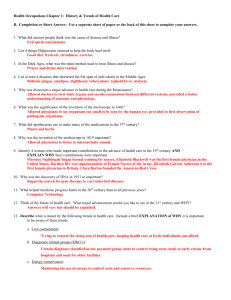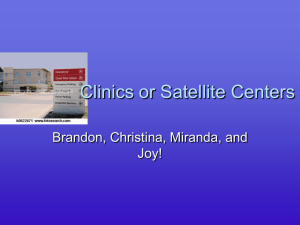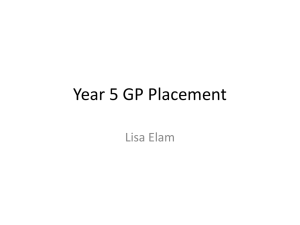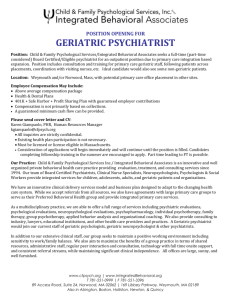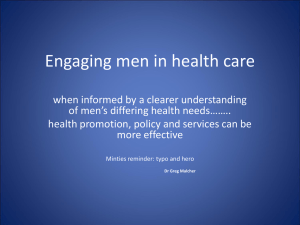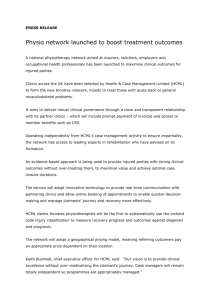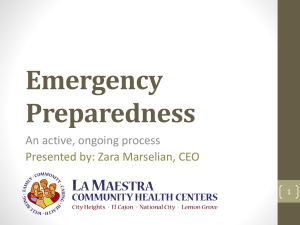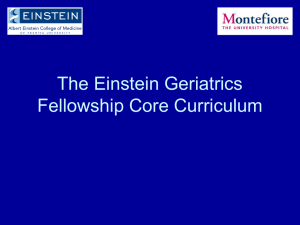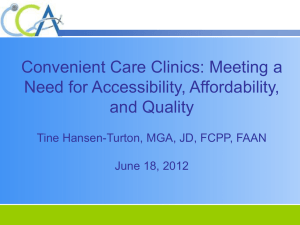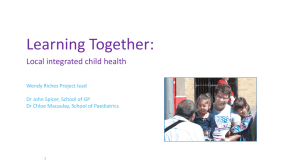Health Care Systems Worksheet: Key Concepts & Agencies
advertisement
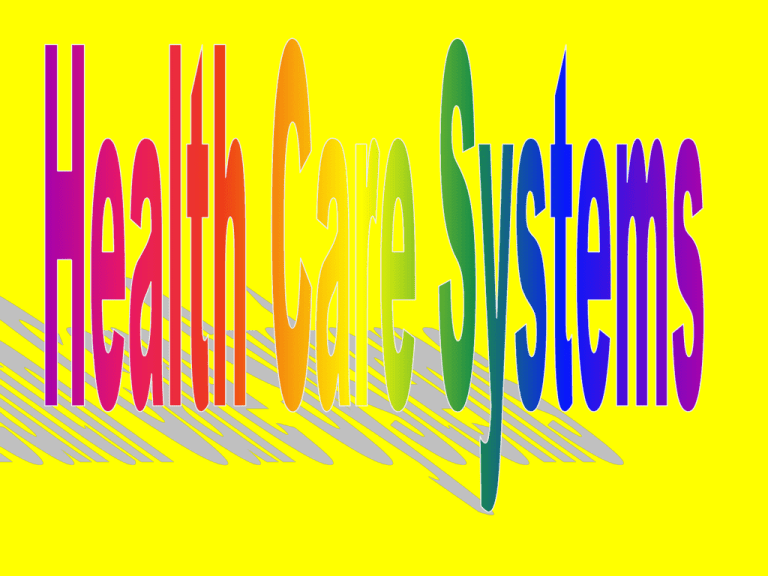
1. Unscramble these words ! RAALOTBYRO TLEHHA NNCIAMTNAEE OLGN ETMR AREC UNLTISIDAR ETHLAH MNCEGEREY AECR LNTEMA LHTEHA Unscramble these words ! LNCCII EAIINRIABHTLTO POTSAHIL 2. Place the name of the type of health care facility by the brief description of the facility. a. provide assistance and care for mainly the elderly b. provides special care for accidents or sudden illness c. deal with mental disorders and diseases d. health centers located in large companies or offices industries e. Offices owned by one or more dentists f. perform a special diagnostic tests g. provide care in a patient’s home h. provide physical, occupational, and other therapies 3. Hospitals are classified into four types depending on the sources of income received. List the 4 main types. 4. List (3) services offered by medical offices 5. Identify at least (3) different types of clinics group of doctors who share a facility, groups who provide special care, outpatient clinics health department clinics, medical center clinics at colleges or universities. 6. List (3) examples of services that can be provided by home health care agencies 7. What is the purpose or main goal for the care provided by rehabilitation facilities? help patients with physical or mental disabilities obtain maximum self-care and function 8. Identify (3) services offered by school health services. • 1) Perform tests to check for health conditions • 2) Promote health education • 3) Maintain a safe and secure school environment • 4)Emergency care for accidents or sudden illness • 9. An international agency sponsored by the United Nations is the? • A national agency that deals with health problems in America is the? Another national organization that is involved in the research of disease is the? A federal agency that establishes & enforces standards that protect workers from job –related injuries & illnesses is the? 10. List (4) services that can be offered by state and local health departments 1) Immunization for disease control 2) Inspections for environmental health and sanitation 3) Collection of statistics and records 4) Health education 5) Clinics 11. Nonprofit or voluntary agencies provide many services. A. How do Non-Profit & Voluntary receive their funding? b. List 2 services provided by these facilities (non-profit or voluntary agencies) • Study disease, • provide funding for research, promote public education, • provide special services to victims of disease • provide treatment centers, • supply information about other community agencies. Define the following terms related to insurance plans. 1) a payment made to the insurance company 2) amounts that must be paid by the patient Define the following terms related to insurance plans 1) another type of insurance plan(health maintenance organization) 2) another type of health insurance plan usually provided by large 13. What is one advantage to HMOs? ADVANTAGE - Monthly fee the same regardless of the amount of care, directed toward Preventative care, ready access to health examinations and early treatment What is one disadvantage to HMOs? DISADVANTAGE - Required to use only HMO-affiliated health care providers 14. Why has the concept of managed care developed? developed in response to rising cost of health care What is the principle behind managed car? The principle behind managed care is that all health care provided to a patient must have a purpose. 15. Identify the individuals who are usually covered under the following plans 1) individuals over the age of 65 and for any person with a disability who has received social security benefits for at least 2 years 15. Identify the individuals who are usually covered under the following plans individuals with low income and children who qualify for public assistance Workers who are injured on the job 16. What is the purpose for an organizational structure in a health care facility? Shows a line of authority to indicate areas of responsibility and lead and to efficient operation 17. Care that promotes physical, emotional, and social well being 18. The Omnibus Budget Reconciliation Act (OBRA) of 1987 established standards for geriatric assistants in long-term care facilities. List four (4) requirements that all geriatric assistants must meet as a result of OBRA. 1) Complete a state approved training program 2) Pass a written and/or competency examination 3) Continuing education, periodic evaluation of performance 4) Establish training and competency evaluation programs for nursing and geriatric assistance 19. Describe what is meant by the following trends in health care. Include a brief explanation of why it is important to be aware of these trends. Cost containment: trying to control the rising cost of health care, keep health care at levels individuals can afford diagnostic related groups (DRGs) certain diagnoses classified in one payment group, done to control rising costs, leads to early release from hospitals & need for other facilities home health care providing care in the home, increasing due to early hospital release due to DRGs, desire of patients for care in home Geriatric care care of the elderly, increasing due to increase in life span & also large number of people who are approaching this age group federal act that led to Omnibus Budget development of many Reconciliation regulations regarding Act (OBRA) long-term care; nursing assistants must complete training program & pass a competency test to obtain certification or registration also requires compliance with patients/resident’s rights Wellness state of being in optimum health more awareness of good health & more stress on preventing or delaying disease alternative methods of health care individuals seek other types of treatment for a variety of conditions, health care worker most respect person’s right to receive this care ~*~ QUESTIONS ~*~ 1) Isolated radium in 1910 2) Established the patterns of heredity 3) Developed a vaccine for smallpox in 1796 4. Describe the L. William Harvey circulation of blood to & from Heart 5. Began public health V. Romans & sanitation systems 6. Discovered x rays U. William Roentgen in 1895 7. The father of medicine M. Hippocrates 8. Discovered penicillin in 1932 I. Sir Alexander Fleming 9. Artist who used dissection to draw the human body D. Leonardo da Vinci 10. Pandemic of bubonic plague E. Dark Ages killed millions of people 11. Founded the American Red Cross in 1881 A. Clara Barton 12. Earliest people known to maintain accurate health records. G. Egyptians 13. Began pasteurizing milk to kill bacteria S. Louis Pasteur 14. Used acupuncture to relieve pain & congestion. B. Chinese 15. Developed the culture plate O. Robert Koch method to identify pathogens. 16. Founder of modern nursing R. Florence Nightingale 17. Began using disinfectants & antiseptics during surgery P. Joseph Lister 18. Created the first mercury thermometer H. Gabrial Fahrenheit 19. Developed the polio vaccine in 1952 W. Jonas Salk 20. An Arab physician who began the use of animal gut for suture material T. Rhazes

